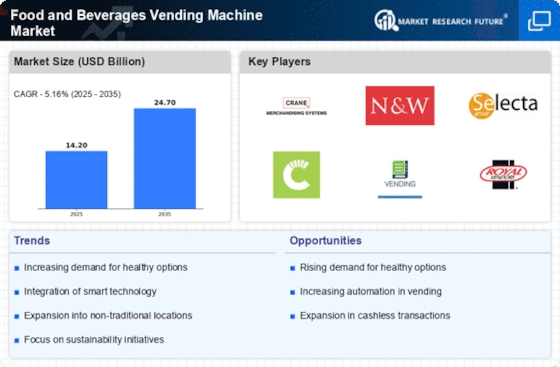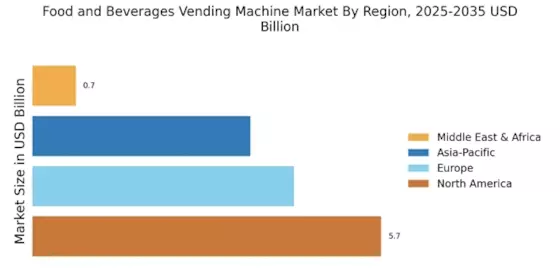Health and Wellness Trends
In recent years, there has been a marked shift towards health and wellness, significantly impacting the Food and Beverages Vending Machine Market. Consumers are increasingly seeking healthier snack and beverage options, prompting vending machine operators to diversify their offerings. According to market data, the demand for organic, low-calorie, and nutrient-rich products has risen sharply, with many consumers willing to pay a premium for healthier choices. This trend is further supported by the growing awareness of nutrition and wellness, leading to a potential increase in sales for vending machines that cater to these preferences. Consequently, operators who adapt their product lines to include health-conscious options may find themselves at a competitive advantage.
Sustainability Initiatives
Sustainability is becoming a pivotal concern within the Food and Beverages Vending Machine Market. As environmental awareness grows, consumers are increasingly favoring brands that demonstrate a commitment to sustainability. This trend is prompting vending machine operators to adopt eco-friendly practices, such as using biodegradable packaging and sourcing products from sustainable suppliers. Market data suggests that consumers are more likely to choose vending machines that align with their values regarding environmental responsibility. Consequently, operators who implement sustainable practices may not only enhance their brand image but also attract a broader customer base. This shift towards sustainability could potentially reshape the competitive landscape of the industry.
Technological Advancements
The Food and Beverages Vending Machine Market is experiencing a notable transformation due to rapid technological advancements. Innovations such as cashless payment systems, touchless interfaces, and IoT connectivity are enhancing user experience and operational efficiency. For instance, the integration of mobile payment options has been shown to increase transaction speed and customer satisfaction. Furthermore, the use of data analytics allows operators to monitor inventory levels in real-time, optimizing restocking processes. This technological evolution not only attracts tech-savvy consumers but also streamlines operations, potentially leading to increased profitability. As a result, the industry is likely to see a surge in demand for modern vending solutions that incorporate these advanced technologies.
Urbanization and Convenience
The ongoing trend of urbanization is significantly influencing the Food and Beverages Vending Machine Market. As more people migrate to urban areas, the demand for convenient food and beverage options continues to rise. Vending machines provide an accessible solution for busy urban dwellers seeking quick snacks and drinks. Market data indicates that urban areas are witnessing a higher concentration of vending machines, particularly in high-traffic locations such as office buildings, schools, and transportation hubs. This convenience factor is likely to drive growth in the industry, as consumers increasingly prioritize speed and accessibility in their purchasing decisions. Therefore, the expansion of vending machine networks in urban settings could lead to enhanced market penetration.
Customization and Personalization
The demand for customization and personalization is reshaping the Food and Beverages Vending Machine Market. Consumers are increasingly seeking tailored experiences, which extends to their food and beverage choices. Vending machines that offer customizable options, such as build-your-own snack combinations or personalized drink selections, are gaining popularity. Market data indicates that personalized offerings can lead to higher customer satisfaction and repeat purchases. This trend is particularly evident among younger consumers, who value unique and individualized experiences. As a result, vending machine operators who embrace customization may find themselves better positioned to meet evolving consumer preferences, potentially leading to increased market share.


















Leave a Comment